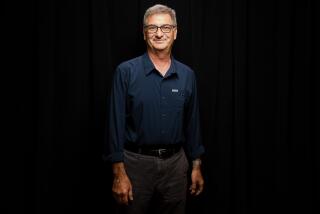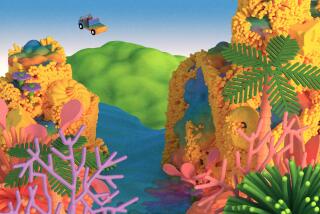‘The Most Innovative City in the World’
- Share via
CURITIBA, Brazil — At the start of the school year, Christiano Pereira Pinheiro, a winsome 7-year-old, traded 8 pounds of recyclable garbage for a packet of new notebooks.
Each week, he and his two older brothers, the sons of a maid and a steelworker, exchange trash for fresh fruit or 2 pounds of protein-rich beans. At Easter, they get chocolate eggs and at Christmas a cake for the family.
Garbage is not the only thing recycled here. Old wooden utility posts are reused in office buildings, bridges and public squares. Retired buses become mobile classrooms for adult education. A gunpowder depot converts into a theater-in-the-round.
“Virtually everything has more than one use,” said Mayor Rafael Greca De Macedo, whose airy office overlooking a park is made of old telephone poles and glass. “It’s just a matter of figuring out how to reuse things and then teaching people how to do it.”
Curitiba has done just that--and much more. As the world’s mayors and urban planners assemble today in Istanbul, Turkey, for the start of a U.N. summit on mushrooming urban problems, this little-known city in southeast Brazil is being heralded as the place that has many of the solutions.
“It’s the most innovative city in the world,” said Wally N’Dow of Gambia, chairman of the Habitat II summit. Since young maverick architects and engineers took over City Hall in the 1970s, Curitiba has tried new ways to tackle such urban ills as illiteracy, homelessness, transportation and government service shortcomings, unemployment, pollution and poverty.
Curitiba is still a Third World city, with at least 10% of its 1.6 million people living in slums of corrugated tin-and-wood shanties. And its innovations--from “trade villages” to schoolbooks written by the mayor--were made gradually.
But the city now stands as a model for urban planners, and mayors from around the world have visited Curitiba to learn from its experiments.
The rush to the cities has been one of the great global trends of the 20th century. Forty years ago, 70 cities had more than 1 million people. Today there are more than 200, including 10 in Brazil. And in 15 years, the United Nations estimates, there will be 500, with 33 having populations of more than 10 million.
“The 21st century will be the first urban century,” N’Dow said, “with more than half the world’s population living in cities. But whether in big countries such as the United States or small countries like mine, we are all woefully unprepared.”
In an effort to share possible solutions, Habitat II has identified 227 innovative practices in cities from Bogota, Colombia, to Bangkok, Thailand. Jakarta, Indonesia, is cited for uniting the public and private sectors in a housing development project. Havana is mentioned for the way it has provided housing, roads, clean water and electricity to the poor.
In the United States, Habitat’s premier example is Chattanooga, Tenn., which in 1969 was the most polluted American city, rapidly losing people and jobs. Under the management of David Crockett, a descendant of the frontiersman, Chattanooga has done an about-face, making major strides in such areas as pollution control, neighborhood revitalization and public education. The President’s Council on Sustainable Development has chosen it as one of three “laboratory” cities.
Impressive Advances
Matched up against Chattanooga, Curitiba seems all the more impressive. It is in a poor country where rural dwellers are streaming into the cities at a rate that makes Los Angeles’ once-booming growth look tame.
Elsewhere in Brazil, Sao Paulo, whose 18 million residents make it the world’s third-largest metropolis, is a dirty, disorienting mega-city. Rampant crime plagues Rio de Janeiro, where up to a third of the 5.5 million residents live in shanties. Brasilia, the capital, is a sterile planned city of 1.8 million whose outdated 1960s architecture gives it an eerie feel.
The accomplishments of Curitiba have come despite limited means. For a city its size, its budget is modest: $1 billion a year, the same as that of Lausanne, Switzerland, which has one-tenth the population.
But Curitiba is making the most of what it has.
Its “garbage that is not garbage” program made it the world’s recycling capital. More than 70% of its trash is recycled--compared with the 25% mandated in Los Angeles and the 10% rate nationwide in the United States. Paper recycling in Curitiba saves 1,200 trees a day, city planners estimate.
The program in turn helps the poor. The city last year exchanged almost 2 million pounds of food, 348,000 Easter eggs and 26,000 Christmas cakes for recyclable trash. Hundreds of quilts for the needy were stuffed with crushed Styrofoam. Christiano was one of 25,000 poor children who received school supplies.
The program also keeps the town clean, cuts diseases spread by rat urine and helps prevent the persistent floods that used to occur when townspeople threw their garbage into rivers.
Environmental efforts are only a small part of the ever-expanding plan for Curitiba.
Learning Lighthouses
The latest additions are the Lighthouses of Learning, based on the great lighthouse and library in Alexandria, Egypt, one of the ancient world’s seven wonders.
The brightly colored lighthouses have 5,000-volume libraries on the first floor, reading rooms on the second and a guard in a light tower that transmits a strong beam to provide community security. The first lighthouse was built last year; two more open every month. Curitiba should have 50 by the end of the year.
“One of the lighthouses is three blocks from my home, so I use it for all my school projects,” said Deucina Romana Costa, a high school senior who stops in every couple of weeks. “So do my 10-year-old brother and 12-year-old sister. Mom lets them come because it’s safe.”
An average of 25,000 people have taken out library cards at each lighthouse. “This is very important in a country where the schools have no books, where teachers were educated with notebooks or photocopies, not texts, and where people for 500 years have been forbidden to think,” Mayor Greca said.
The lighthouses have become the focal point of their neighborhoods and have cut crime rates. They each cost about $180,000--or one-third the price of a kilometer of asphalt road. “It’s cheaper to build libraries than prisons,” said Greca, an engineer by training.
Curitiba also is taking government to the people. Citizenship Streets are colorful covered avenues of government offices and shops where residents can pay utility bills, get a marriage license or file a police report. They can also get a haircut, buy groceries or work out. Shop rents pay most of the costs.
The streets also have 600-seat open theaters, night courts and classrooms that offer vocational training for $1 a course. In one recent computer class, Marta Casavechia Penha, a 28-year-old teacher, said she enrolled because “the price is right. With my income, this is the only route to advancement.”
Next to her sat Everton Cesar Lourenco, a high school junior who wants to go into management but can’t afford college. He had to finish the 10-week typing course next door before getting into the computer course. “This class is my future,” he said.
The first Citizenship Street opened last year; six more are planned by early 1997. They reflect one of the keys to Curitiba’s success: integration. Each Citizenship Street, for example, is linked to one of the city’s seven transportation hubs.
Transport Solution
Transportation is what sparked the reinvention of Curitiba.
As rural migrants tripled its population over the last three decades, the city needed a subway system it could not afford. So in 1991 it built an “above-ground subway.”
At sidewalk stations that look like tubes of darkened glass, passengers board elongated express cars that hold up to 275 people. Five lines intersect with normal bus routes.
Although Curitiba has more cars per resident than any Brazilian city except Brasilia, 85% of commuters use mass transportation. Fuel consumption is 25% lower per capita than the national average.
The transport centers are near health facilities, of which Curitiba has the most per capita in Brazil--all open 24 hours a day. The clinics and environmental programs have cut infant mortality in half over the last decade; it is now only one-third of the national average of more than 50 deaths per 1,000 births.
Curitiba has not overlooked its schools. Christiano, a second-grader, uses one of the four-volume “Lessons From Curitiba” textbooks written by the mayor and local teachers. Numbers are taught using local flora and fauna. The poem in a reading lesson explains that emeralds are worth a lot and diamonds much more, but even more valuable is glass because it can be recycled again and again. Math problems probe how much of the local environment can be saved through various kinds of recycling.
“We’re trying to create a whole new set of attitudes and a sense of involvement,” Greca said. Students pay for their books in recyclable trash; each book itself is recycled to the next year’s students.
In 1991, Curitiba built the Free University for the Environment--from old utility posts--next to a quarry converted into a lake. Short courses on how to make better use of the environment are tailored for homemakers, contractors and merchants. Taxi drivers have to take a course to get an operator’s license.
“A lot of these ideas came from a game started 20 years ago when we were at the university,” said Mauro Magnabosco, president of the Curitiba Institute for Urban Planning and Research. “We looked at what we needed and how we could get it or make it from what we already had. It made us look at recycling as rescuing the past to build a better future.”
Each program has built-in incentives. Maria Jose Dias, a former domestic worker, lived with her mother-in-law for 23 years until she moved into the first of several new “trade villages”--neighborhoods for low-income families that combine housing and workshops and were inspired by medieval towns.
Dias runs a concession stand and catering business from the small shop and kitchen that she rents on the ground floor. She and her husband live upstairs. They will win the right to buy the property if they can make a go of the business for two years.
“It’s the first shot we’ve had at being independent,” said Dias, 48. The villages, which eventually will provide 400 workshop-homes, are also one of several ways to distribute business around the city. The 16 establishments in Dias’ village include bicycle rental and gift stores, a hairdresser and an electronics repair shop.
Funding Facilities
With its limited municipal budget, Curitiba has designed many of its programs to help pay for themselves.
After school, Christiano goes to one of 34 environmentally friendly day-care centers, where he makes papier-mache masks of animals facing extinction or folds shiny magazine pages into strips to weave baskets that are varnished and sold in a string of souvenir shops. The profits help pay for the facilities. In a small backyard garden, one of his brothers helps grow spinach, spring onions and other vegetables for lunch.
Greca shared Curitiba’s working philosophy.
“The city is the best human invention,” he said. “But to make it work, a city’s society must be understood as a train that will go no faster than its slowest wagon or car.
“City governments exist to push the slowest car so the whole train will go faster.”
(BEGIN TEXT OF INFOBOX / INFOGRAPHIC)
Model City
The Brazilian city of Curitiba is being heralded as one of the world’s most innovative when it comes to pollution, illiteracy, homelessness and other urban ills.
More to Read
Sign up for Essential California
The most important California stories and recommendations in your inbox every morning.
You may occasionally receive promotional content from the Los Angeles Times.










